- Home
- Introduction
- 1. Design rights
- 1.1. Design rights: overview
- 1.2. What a design right protects
- 1.3. Why protect a design?
- 1.4. How designs are protected in Australia?
- 2. Application for registration
- 2.1. Application for registration: overview
- 2.2. Registration process
- 2.3. Submitting an application
- 2.4. Minimum filing requirements
- 2.5. Who is entitled to be a registered owner?
- 2.6. Types of applications (s 22)
- 2.7. Request for registration
- 2.8. Further designs
- 3. Fees
- 3.1. Fees: overview
- 3.2. Application fees
- 3.3. Renewal fees
- 3.4. Examination fees
- 3.5. Hearing fees
- 3.6. Fees for extensions of time
- 3.7. Refunds
- Production test Designs
- 4. Formalities assessment
- 4.1. Formalities assessment: overview
- 4.2. The ‘Formalities check’ and ‘Formal requirements’
- 4.3. Formalities notices
- 5. Applicant details
- 5.1. Applicant name: overview
- 5.1.1. Is the applicant a person?
- 5.1.2. Individual (Australian and overseas, including joint owners)
- 5.1.3. Australian company (Pty Ltd, Ltd)
- 5.1.4. Strata company, owners corporation, body corporate etc
- 5.1.5. Government entity
- 5.1.6. Incorporated association
- 5.1.7. Overseas entity (AG, S.r.L etc)
- 5.1.8. Several applicant names, multiple designs
- 5.1.9. Joint owner names with ABN
- 5.1.10. Partnership
- 5.1.11. Trust/trustee
- 5.1.12. Business names and 'trading as'
- 5.1.13. Applicant name and design owner
- 5.2. Applicant address
- 6. Representations
- 6.1. Representations: overview
- 6.2. General requirements
- 6.3. Formal compliance
- 6.4. Product
- 6.5. Consistency
- 6.6. Text
- 6.7. Common designs
- 6.8. Drawings
- 6.9. Photographs
- 6.10. Specimens or 3D models
- 6.11. Different views
- 6.12. Environmental views
- 6.13 Pairs and mirror images
- 7. Classification
- 7.1. Classification: overview
- 7.2. Classification systems
- 7.3. Finding the right class
- 7.4. Cases of doubt
- 7.5. More than one possible classification
- 7.6. Multiple products or designs
- 8. Examination and certification
- 8.1. Examination and certification: overview
- 8.2. Examination and certification processes
- 8.3. Requesting examination
- 8.4. Third party initiated examinations
- 8.5. Concurrent requests for examination
- 8.6. Expedited examination
- 8.7. Material provided by a third party
- 8.8. Relevant material that must be considered
- 8.9. Time frame for completion of examination and last-minute responses
- 8.10. Withdrawal of request for examination
- 8.11. Notice of intention to certify
- 8.12. Requests for examination after certification
- 8.13. Further examination reports
- 8.14. Revocation
- 8.15. Examination hearings
- 8.16. Examination on Registrar's initiative
- 9. Identifying the design
- 9.1. Identifying the design: overview
- 9.2. Overall appearance
- 9.3. Visual features
- 9.4. Variable visual features
- 9.5. What cannot be a visual feature
- 10. Product
- 10.1. Product: overview
- 10.2. Identifying the product
- 10.3. Things that are not products
- 10.4. Things that are not different products
- 10.5. Product name
- 10.6. Manufactured or handmade
- 10.7. Component part of a complex product
- 10.8. Assembled set or kit
- 10.9. Indefinite dimensions
- 10.10. Examples - things that are / are not products
- 11. Excluded designs
- 11.1. Excluded designs: overview
- 11.2. Priority date of excluded designs
- 11.3. Extensions of time
- 11.4. Amendments
- 11.5. Registration/publication requests
- 12. Section 43 refusal to register
- 12.1. Section 43 refusal to register: overview
- 12.2. Medals
- 12.3. Anzac
- 12.4. Currency
- 12.5. Scandalous content
- 12.6. Arms, flags, emblems etc.
- 12.7. Olympic symbols
- 12.8. Integrated circuits
- 13. Assessing newness and distinctiveness
- 13.1. Assessing newness and distinctiveness: overview
- 13.2. Product name and intended use
- 13.3. Identifying the product
- 13.4. Test for newness
- 13.5. Test for distinctiveness
- 13.6. Substantially similar in overall impression
- 13.7. How the design is displayed
- 13.8. Other visual features
- 13.9. Searching
- 14. Section 19 requirements for distinctiveness
- 14.1. Section 19 requirements for distinctiveness: overview
- 14.2. Similarities and differences
- 14.3. State of development of the prior art base
- 14.4. Statement of newness and distinctiveness
- 14.5. Amount, quality and importance
- 14.6. Freedom of the creator of the design to innovate
- 14.7. Familiar person / Informed user
- 15. Statement of newness and distinctiveness
- 15.1. Statement of newness and distinctiveness: overview
- 15.2. Formalities assessment of the SoND
- 15.3. Amendments to the SoND
- 15.4. Using the SoND to assess distinctiveness
- 16. Standard of the familiar person / informed user
- 16.1. Standard of the familiar person / informed user: overview
- 16.2. Identifying the familiar person / informed user
- 16.3. Declarations about the familiar person / informed user
- 16.4. Familiarity with the product
- 16.5. References to European and UK decisions
- 16.6. Familiar person’s / informed user’s knowledge base versus prior art base
- 17. Prior art base
- 17.1. Prior art base: overview
- 17.2 Publicly used in Australia
- 17.3. Published in a document within or outside of Australia
- 17.4. Trade marks and patents as citations
- 17.5. Establishing the publication date
- 17.6. Designs disclosed in applications
- 18. Prior publication or use exceptions
- 18.1. Prior publication or use exceptions: overview
- 18.2. Exhibitions
- 18.3. Unauthorised disclosures
- 18.4. Disclosure to government
- 18.5. Copyright
- 18.6. Grace Period
- Annex A - An example of a grace period declaration
- 19. Priority date
- 19.1. Priority date: overview
- 19.2. Convention application
- 19.3. Multiple bases for priority
- 19.4. Plural designs
- 19.5. When priority must be asserted
- 19.6. Excluded designs
- 19.7. Converted applications
- 19.8. Applications by an entitled person
- 20. Convention priority
- 20.1. Convention priority: overview
- 20.2. Convention countries
- 20.3. Time limit to claim convention priority
- 20.4. Assessing convention priority claims
- 20.5. Convention priority for excluded designs and applications that include more than one design
- 20.6. Basic application
- 20.7. Requesting the basic application
- 20.8. Relevance of the basic application to examination
- 21. Satisfied
- 21.1. Satisfied: overview
- 21.2. Meaning of ‘satisfied’
- 21.3. ‘Satisfied’ as to prior art base
- 21.4. Reasonable doubt, balance of probabilities and uncertainty
- 21.5. ‘Not satisfied’
- 22. Amendments
- 22.1. Amendments: overview
- 22.2. Amending an application
- 22.3. Amending a registration
- 22.4. Inclusion of matter not in substance disclosed
- 22.5. Increasing the scope of the design registration
- 22.6. Other types of amendments
- 23. Extensions of time
- 23.1. Extensions of time: overview
- 23.2. Legal principles
- 23.3. Error or omission by the Registrar
- 23.4. Error or omission by the customer
- 23.5. Circumstances beyond the customer’s control
- 23.6. Registrar’s discretion
- 23.7. Protection for third parties
- 23.8. Period of extension
- 23.9. Extensions process
- 23.10. Advertisement
- 23.11. Request from an unrecorded new owner
- 23.12. Extension of the convention priority period
- 24. Assignments (and other interests)
- 24.1. Assignments and other interests: overview
- 24.2. Recording changes of ownership
- 24.3. Possible complications
- 24.4. Bankruptcy and winding up
- 24.5. Registering other interests
- 25. Ownership disputes
- 25.1. Ownership disputes: overview
- 25.2. Disputes between joint applicants
- 25.3. Disputes where a non-applicant claims ownership
- 25.4. Disputes where some designs have been registered or published
- 25.5. Disputes about recording a change of ownership before registration
- 25.6. Typical situations where ownership disputes arise
- 25.7. Revocation after an ownership dispute
- 26. Production of documents under s 61(1)
- 26.1. Production of documents under s 61(1): overview
- 26.2. Powers of the courts
- 26.3. Powers of the Registrar
- 26.4. Precedent
- 26.5. Who access is granted to
- 26.6. Access in ownership disputes
- 26.7. Where inspection can take place
- 26.8. Right of lien
- 26.9. Draft undertaking for access
- 27. Publication and file access
- 27.1. Publication and file access: overview
- 27.2. Designs not publicly available
- 27.3. Legal exceptions
- 27.4. Freedom of information
- 27.5. Prohibition orders
- 28. Hearings
- 28.1. Hearings: overview
- 28.2. Filing evidence
- 28.3. Disputes over whether the design was new and distinctive at the priority date
- 28.4. Interface with court proceedings
- 29. Glossary
- 30. Citation index
- 31. Keyword index
- 32. Classification listings
- Class Heading Summary
- Class 01 Foodstuffs
- Class 02 Articles of clothing and haberdashery
- Class 03 Travel goods, cases, parasols and personal belongings not elsewhere specified
- Class 04 Brushware
- Class 05 Textile piecegoods, artificial and natural sheet material
- Class 06 Furnishing
- Class 07 Household goods not elsewhere specified
- Class 08 Tools and hardware
- Class 09 Packages and containers for the transport or handling of goods
- Class 10 Clocks and watches and other measuring instruments, checking and signalling instruments
- Class 11 Articles of adornment
- Class 12 Means of transport or hoisting
- Class 13 Equipment for production, distribution or transformation of energy
- Class 14 Recording, communication or information retrieval equipment
- Class 15 Machines not elsewhere specified
- Class 16 Photographic, cameras, cinematographic and optical apparatus
- Class 17 Musical instruments
- Class 18 Printing and office machinery
- Class 19 Stationery and office equipment, artists and teaching materials
- Class 20 Sales and advertising equipment, signs
- Class 21 Games, toys, tents and sporting goods
- Class 22 Arms, pyrotechnic articles, articles for hunting, fishing and pest killing
- Class 23 Fluid distribution equipment, sanitary, heating, ventilation and air conditioning equipment, solid fuel
- Class 24 Medical and laboratory equipment
- Class 25 Building units and construction elements
- Class 26 Lighting apparatus
- Class 27 Tobacco and smokers supplies
- Class 28 Pharmaceutical and cosmetic products, toilet articles and apparatus
- Class 29 Devices and equipment against fire hazards, for accident prevention and rescue
- Class 30 Articles for the care and handling of animals
- Class 31 Machines and appliances for preparing food or drink, not elsewhere specified
- Class 32 Graphic symbols and logos, surface patterns, ornamentation
- 33. Designs (Formal Requirements for Designs Documents) Instrument 2022
10.9. Product: Indefinite dimensions
A thing that includes one or more indefinite dimensions as part of its design can be considered a product under s 6(3).
A claim for indefinite dimensions is typically aimed at the length and/or width of the product. These are represented using break lines, and it should be obvious that this is the purpose of the lines and not as visual features of the design. Break lines are displayed using a single or double line including a jagged, sinusoidal or zigzag feature.
Examples of different products that include claims for indefinite dimensions, shown using break lines, are provided further on.
Subsection 6(3)
The design of a product with one or more indefinite dimensions is capable of being protected as long as one of the following categories contained in s 6(3) applies:
- The cross-section of any indefinite dimension shows that the design either is fixed or varies according to a regular pattern.
- All the dimensions of the item remain in proportion.
- The cross-sectional shape is the same throughout, regardless of whether the dimensions of that shape vary according to a ratio or series of ratios.
- The item has a pattern or ornamentation that repeats itself.
Things with indefinite dimensions can include:
- simple extrusions where the shape or dimension of the item does not vary in cross-section (e.g. a pipe)
- products that have a repeating pattern (e.g. textiles).
Background and history for designs with indefinite dimensions
Background to the concept of indefinite dimensions can be found in the Designs Australian Law Reform Commission (ALRC) Report 74. Some relevant details from this report have been reproduced below.
A number of submissions were made on this issue and some stated that products that have indefiniteness in a different direction to the length should be afforded protection or that protection should not be restricted to products that have repeating or recurring elements in the design.
Similarly, a requirement that there be a regular cross-section was also seen as unduly restrictive, as it would not allow for extrusions with holes at regular intervals throughout the length. Provided the holes were repeated at regular intervals then the design of the extrusions should be able to be registered.
One submission argued:
- Indefinite length and width should only be permitted where a design element such as a pattern repeats itself throughout the length and width of the product
- Products of indefinite length should be protected if the cross-section of the product is constant throughout its length, or the width and height remain in a proportional relationship
- Where a particular feature is repeated at regular intervals along the indefinite length, that also should be protectable.
The ALRC agreed with this submission and all elements above were included in a new and more specific provision identifying what is protectable where there are one or more indefinite dimensions.
Indefinite Dimensions and Formalities Assessment
A design application must include any indefinite dimension(s) in a clear and readily understandable manner; see s 7(15) Designs Formal Requirements Instrument.
Where an application is submitted that claims a thing of indefinite dimension(s), and there is uncertainty as to:
- what the representation(s) are attempting to assert as meeting s 6(3), or
- that the representation(s) can and are likely to be interpreted in more than one way
The formalities officer may query the representations with the applicant, asking for further information or an indication from the applicant as to which s 6(3) scenario the application fits into.
The design of a product with one indefinite dimension, for example varying length but with the same cross section throughout, should be able to be protected.
The design of a product with more than one indefinite dimension should be able to be protected provided that at least one of the following applies to the product or that part of the product which is of indefinite dimension:
- a cross section taken across any indefinite dimension is fixed or varies according to a regular pattern – s 6(3)(a)
- all the dimensions remain in proportion – s 6(3)(b)
- the cross-sectional shape remains the same throughout, whether or not the dimensions of that shape vary according to a ratio or series of ratios – s 6(3)(c)
- it has a pattern or ornamentation that repeats itself – s 6(3)(d).
Practically speaking the provisions of s 6(3) were drafted to cover a range of situations, such as:
- the indefinite dimension applies to the entire length of the product – such as simple extrusion
- the indefinite dimension applies to only part of the article – such as the body-section of a bottle, or the panel section of a door
- the indefinite dimension applies to part of an article in two dimensions – such as the width and height of a window frame.
More detailed information about each of the s 6(3) criteria is included below from Parts 10.9A - 10.9D.
10.9A. Design either is fixed or varies according to a regular pattern
A product design with indefinite dimensions should be able to be registered as long as the cross-section of any indefinite dimension shows that the design either is fixed or varies according to a regular pattern.
This category includes for example:
- simple extrusions that do not vary in cross-section shape or dimension
- extrusions that vary in the cross-sectional shape or dimension but have a repeating pattern along the indefinite dimension. Newness and distinctiveness is assessed on the repeating pattern along the length rather than on the shape of the cross-section
- things where part of the thing along that dimension is indefinite – such as a midsection of indeterminate length. In this situation the requirement regarding variation according to a regular pattern applies to the section that is indicated to be of indeterminate length (the midsection).
A product that is indefinite in 2 or more dimensions will not fall into this category if the cross-section in one dimension intersects with the cross-section in another direction. This is because the cross-section in at least one of those dimensions is not fixed.
Example: Design is fixed (Design 202013592)
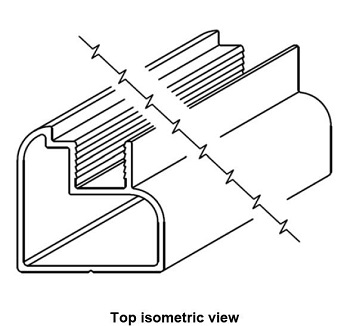
The cross-section across the indefinite dimension (length) is limited to a fixed shape.
Example: indefinite dimension applies to part of product only (Design 201912617)
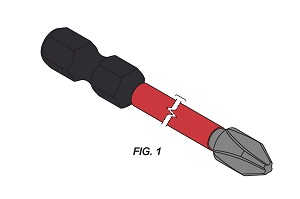
Only the shank is of indefinite length. It expands in size from what is shown in the representation (becoming longer).
Example: Design varies according to a regular pattern (Design 200912161)
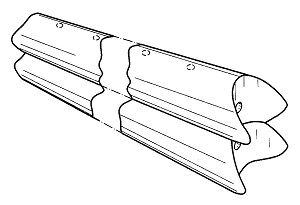
The cross-section across the indefinite dimension (length) varies according to a regular pattern that is seen running along the indefinite dimension. The cross-section does not remain fixed because there are holes present in the roof of the design. However, this variation brought about by the holes does accord to a regular pattern along the indefinite dimension. The cross-section will differ along the indefinite dimension depending on whether there is a gap at the top due to a hole being present.
10.9B. All dimensions remain in proportion
This provision refers to ‘all’ dimensions, so products falling into this category must have more than one (indefinite) dimension. A product design with indefinite dimensions should be able to be registered as long as the cross-section of any indefinite dimension shows that all dimensions remain in proportion.
The category refers to ‘all’ dimensions, so the item must have more than one dimension. It excludes a single indefinite dimension.
This category includes:
- things where both the width and height are indeterminate
- things where the cross-sectional width and height vary randomly along its length but remain in constant proportion.
Example: Dimensions remain in proportion (Design 201913195)

The representation is interpreted as expanding and contracting proportionately. The product has an indefinite width and height, but these vary in proportion. This means that whilst the product may vary in size, the shape and configuration seen above must be retained.
The representation should be interpreted in a manner that gives validity (i.e. that the marked dimensions expand and contract in a corresponding manner) unless there are clear issues with that interpretation or uncertainty as to what is being claimed. Where there is uncertainty as to what visual features expand and contract, and what the line detail included in a representation (such as a break line) signifies, this should be queried.
10.9C. Cross-sectional shape is the same throughout
A product design with indefinite dimensions should be able to be registered as long as the cross-sectional shape is the same throughout.
This category would include, for example, a tube where the cross-sectional shape remains the same but the width and height of the tube vary along its length.
There is no requirement for a repetitive pattern along the length (unlike where a cross-section taken across any indefinite dimension is fixed or varies according to a regular pattern). This category does not apply to extrusions where there are holes or something similar along the length of the extrusion.
Because there is no repetition along the indefinite length, there is no relevant pattern or ornamentation in that dimension. So the newness and distinctiveness must be found in the cross-sectional shape.
Example: cross-section oval shape remains the same throughout, whilst the dimensions along the indefinite length vary according to a series of ratios (Design 201415834)
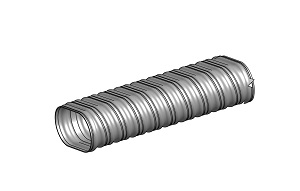
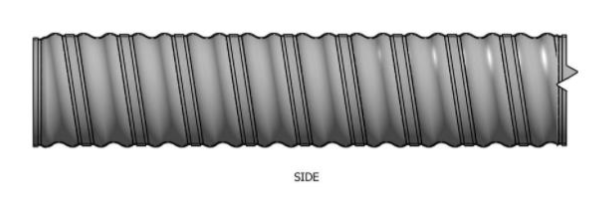
The dimensions (height and width) vary along the indefinite length – the ‘ribbing’ effect. Dimensions remain in proportion, resulting in the oval shape being maintained along the indefinite length.
10.9D. Pattern or ornamentation that repeats itself
A product design with indefinite dimensions should be able to be registered as long as it has a pattern or ornamentation that repeats itself.
This category typically includes textiles and other sheet materials that have repeated surface decorations. For an item to be placed into this category, the representations must show at least one pattern repeat.
There are some issues involved in classifying items into this category:
- In the formalities assessment, it is difficult to correctly identify how many products are present in the application.
- In examination for certification, newness and distinctiveness cannot be found in the relative size of the indefinite dimension.
Example: Product with indefinite height and width but with repeating pattern (Design 201911211)
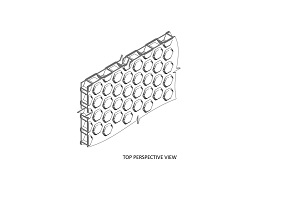
This representation shows indefinite height and width, with a repeating pattern in both directions. The claimed pattern or ornamentation is intended to repeat when applied to the full dimensions of the product bearing the design. The representation(s) must show at least one pattern repeat for this to apply.
Indefinite Dimensions and Examination
An examiner will assess what attention a familiar person / informed user would pay to dimensions that are claimed as being indefinite. An indication of indefiniteness, including both size and inclusion of visual features should itself not equate to a determination of newness and distinctiveness. Indefinite dimensions and indefinitely repeating patterns are not considered visual features. The design as a whole needs to be considered as part of determining overall impression.
Where a representation purports to indicate indefiniteness, but the registration does not fit within the criteria of s 6(3), the thing is still a product capable of registration. However, the representation must be interpreted on the basis of the relevant dimension(s) not being indefinite.
See Assessing newness and distinctiveness for more information on assessing items with indefinite dimensions.
Amended Reasons
| Amended Reason | Date Amended |
|---|---|
Minor clarifications. |
